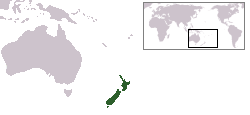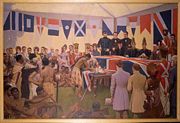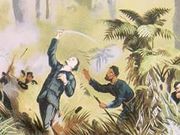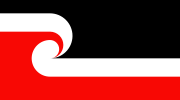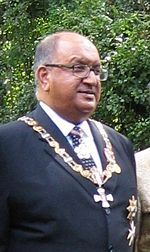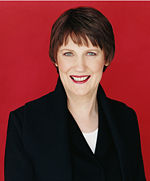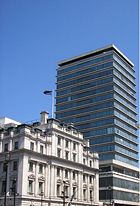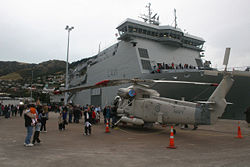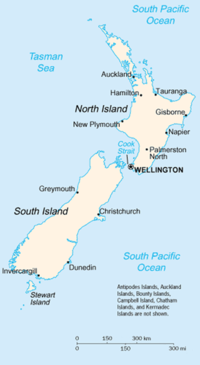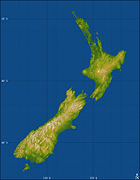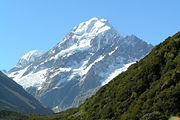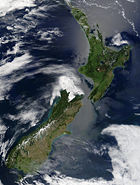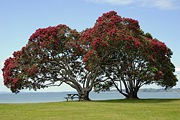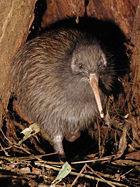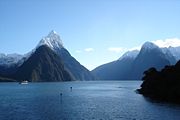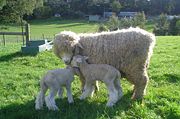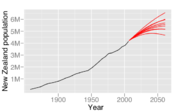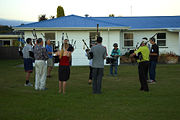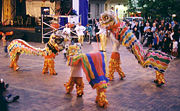New Zealand
2008/9 Schools Wikipedia Selection. Related subjects: Oceania (Australasia)
| New Zealand Aotearoa ( Māori) |
||||||
|---|---|---|---|---|---|---|
|
||||||
| Anthem: " God Defend New Zealand" " God Save the Queen"1 |
||||||
|
|
||||||
| Capital | Wellington |
|||||
| Largest city | Auckland2 | |||||
| Official languages | English (98%)3 Māori (4.2%)3 NZ Sign Language (0.6%)3 |
|||||
| Demonym | New Zealander, Kiwi (colloquial) | |||||
| Government | Parliamentary democracy and Constitutional monarchy | |||||
| - | Head of State | HM Queen Elizabeth II | ||||
| - | Governor-General | Anand Satyanand | ||||
| - | Prime Minister | Helen Clark | ||||
| Independence | from the United Kingdom | |||||
| - | Dominion | 26 September 19074 | ||||
| - | Statute of Westminster | 11 December 1931 (adopted 25 November 1947 ) | ||||
| - | Constitution Act 1986 | 13 December 1986 | ||||
| Area | ||||||
| - | Total | 268,680 km² ( 75th) 103,738 sq mi |
||||
| - | Water (%) | 2.1 | ||||
| Population | ||||||
| - | December 2007 estimate | 4,268,0005 ( 122nd (2008)) | ||||
| - | 2006 census | 4,143,2796 | ||||
| - | Density | 15/km² ( 204th) 39/sq mi |
||||
| GDP ( PPP) | 2008 IMF estimate | |||||
| - | Total | $117.696 billion7 ( 58th) | ||||
| - | Per capita | $27,785 ( 28th) | ||||
| GDP (nominal) | 2008 IMF estimate | |||||
| - | Total | $128.071 billion8 ( 53rd) | ||||
| - | Per capita | $30,234 ( 27th) | ||||
| Gini (1997) | 36.2 (medium) | |||||
| HDI (2007) | ▲ 0.943 (high) ( 19th) | |||||
| Currency | New Zealand dollar ( NZD) |
|||||
| Time zone | NZST9 ( UTC+12) | |||||
| - | Summer ( DST) | NZDT ( UTC+13) | ||||
| (Sep to Apr) | ||||||
| Internet TLD | .nz10 | |||||
| Calling code | +64 | |||||
| 1 "God Save the Queen" is officially a national anthem but is generally used only on regal and vice-regal occasions. 2 Auckland is the largest urban area; Auckland City is the largest incorporated city. 3 Percentages do not add to 100% because some people speak more than one language. They exclude unusable responses and those who spoke no language (e.g. too young to talk). 4 There is a multitude of dates that could be considered to mark independence (see Independence of New Zealand). 5 Estimated resident population of New Zealand on 22 June 2008 NZ Population Clock 6 New Zealand census 2006 final figures, including overseas visitors. PDF (370 KB) 7 IMF GDP PPP Report for selected countries. 8 IMF GDP report for selected countries. 9 The Chatham Islands have a separate time zone, 45 minutes ahead of the rest of New Zealand. 10 The territories of Niue, the Cook Islands and Tokelau have their own cctlds, .nu, .ck and .tk respectively. |
||||||
New Zealand is an island nation in the south-western Pacific Ocean comprising two main landmasses (the North Island and the South Island) and numerous smaller islands, most notably Stewart Island/Rakiura and the Chatham Islands. The indigenous Māori named New Zealand Aotearoa, which is commonly translated into English as The Land of the Long White Cloud. The Realm of New Zealand also includes the Cook Islands and Niue, which are self-governing but in free association; Tokelau; and the Ross Dependency (New Zealand's territorial claim in Antarctica).
New Zealand is notable for its geographic isolation, situated about 2000 km (1250 miles) southeast of Australia across the Tasman Sea, and its closest neighbours to the north are New Caledonia, Fiji and Tonga. During its long isolation New Zealand developed a distinctive fauna dominated by birds, many of which became extinct after the arrival of humans and the mammals they introduced.
The population is mostly of European descent, with the indigenous Māori being the largest minority. Asians and non-Maori Polynesians are also significant minorities, especially in the cities. Elizabeth II, as the Queen of New Zealand, is the Head of State and, in her absence, is represented by a non-partisan Governor-General. The Queen 'reigns but does not rule.' She has no real political influence, and her position is essentially symbolic. Political power is held by the democratically elected Parliament of New Zealand under the leadership of the Prime Minister, who is the Head of Government.
Etymology
It is unknown whether Māori had a name for New Zealand as a whole before the arrival of Europeans, although they referred to the North Island as Te Ika a Māui (the fish of Māui) and the South Island as Te Wai Pounamu (the waters of greenstone) or Te Waka o Aoraki (the canoe of Aoraki). Until the early 20th century, the North Island was also referred to as Aotearoa (colloquially translated "land of the long white cloud"); in modern Māori usage, this name refers to the whole country. Aotearoa is also commonly used in this sense in New Zealand English.
The first European name for New Zealand was Staten Landt, the name given to it by the Dutch explorer Abel Tasman, who in 1642 became the first European to see the islands. Tasman assumed it was part of a southern continent connected with land discovered in 1615 off the southern tip of South America by Jacob Le Maire. The name New Zealand originated with Dutch cartographers, who called the islands Nova Zeelandia, after the Dutch province of Zeeland. No-one is certain exactly who first coined the term, but it first appeared in 1645 and may have been the choice of cartographer Johan Blaeu. British explorer James Cook subsequently anglicised the name to New Zealand. There is no connection to the Danish Zealand.
History
New Zealand is one of the most recently settled major land masses. The first settlers of New Zealand were Eastern Polynesians who came to New Zealand, probably in a series of migrations, sometime between around AD 800 and 1300. Over the next few centuries these settlers developed into a distinct culture now known as Māori. The population was divided into Iwi (tribes) and hapū (subtribes) which would co-operate, compete and sometimes fight with each other. At some point a group of Māori migrated to the Chatham Islands where they developed their own distinct Moriori culture.
The first Europeans known to have reached New Zealand were Dutch explorer Abel Janszoon Tasman and his crew in 1642. Several of the crew were killed by Māori and no Europeans returned to New Zealand until British explorer James Cook's voyage of 1768–71. Cook reached New Zealand in 1769 and mapped almost all of the coastline. Following Cook, New Zealand was visited by numerous European and North American whaling, sealing and trading ships. They traded European food and goods, especially metal tools and weapons, for Māori timber, food, artefacts and water. On occasion, Europeans traded goods for sex. Māori agriculture and warfare were transformed by the potato and the musket, although the resulting Musket Wars died out once the tribal imbalance of arms had been rectified. From the early nineteenth century, Christian missionaries began to settle New Zealand, eventually converting most of the Māori population, who had become disillusioned with their indigenous faith by the introduction of Western culture.
Becoming aware of the lawless nature of European settlement and increasing interest in the territory by the French, the British government sent William Hobson to New Zealand to claim sovereignty and negotiate a treaty with Māori. The Treaty of Waitangi was first signed in the Bay of Islands on 6 February 1840. The drafting was done hastily and confusion and disagreement continues to surround the translation. The Treaty is regarded as New Zealand's foundation as a nation and is revered by Māori as a guarantee of their rights. Hobson initially selected Okiato as the capital in 1840, before moving the seat of government to Auckland in 1841.
Under British rule, the islands of New Zealand had been part of the colony of New South Wales. In 1840 New Zealand became its own dominion, which signalled increasing numbers of European settlers particularly from the British Isles. At first, Māori were eager to trade with the ' Pakeha', as they called them, and many iwi (tribes) became wealthy. As settler numbers increased, conflicts over land led to the New Zealand Land Wars of the 1860s and 1870s, resulting in the loss of much Māori land. The detail of European settlement and the acquisition of land from Māori remain controversial.
Representative government for the colony was provided for by the passing of the 1852 New Zealand Constitution Act by the United Kingdom. The 1st New Zealand Parliament met for the first time in 1854. In 1856 the colony became effectively self-governing with the grant of responsible government over all domestic matters other than native policy. Power in this respect would be transferred to the colonial administration in the 1860s. In 1863 Premier Alfred Domett moved a resolution that the capital transfer to a locality in Cook Strait, apparently due to concern the South Island could form a separate colony. Commissioners from Australia (chosen for their neutral status) advised Wellington as suitable because of its harbour and central location, and parliament officially sat there for the first time in 1865. In 1893, the country became the first nation in the world to grant women the right to vote. In 1907, New Zealand became an independent Dominion and a fully independent nation in 1947 when the Statute of Westminster (1931) was ratified, although in practice Britain had ceased to play any real role in the government of New Zealand much earlier than this. As New Zealand became more politically independent it became more dependent economically; in the 1890s, refrigerated shipping allowed New Zealand to base its entire economy on the export of meat and dairy products to Britain.
New Zealand was an enthusiastic member of the British Empire, fighting in the Boer War, World War I and World War II and supporting Britain in the Suez Crisis. The country was very much a part of the world economy and suffered as others did in the Great Depression of the 1930s. The depression led to the election of the first Labour government, which established a comprehensive welfare state and a protectionist economy.
New Zealand experienced increasing prosperity following World War II. However, some social problems were developing; Māori had begun to move to the cities in search of work and excitement rather than the traditional rural way of life. A Māori protest movement would eventually form, criticising Eurocentrism and seeking more recognition of Māori culture and the Treaty of Waitangi, which they felt had not been fully honoured. In 1975 a Waitangi Tribunal was set up to investigate alleged breaches of the Treaty and in 1985 it was enabled to investigate historic grievances. In common with all other developed countries, social developments accelerated in the 1970s and social and political mores changed. By the 1970s, the traditional trade with Britain was threatened because of Britain's membership of the European Economic Community. Great economic and social changes took place in the 1980s under the 4th Labour government largely led by Finance Minister Roger Douglas, and commonly referred to as " Rogernomics."
Politics
Government
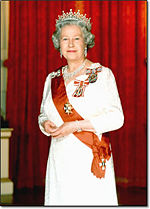
Her Majesty Queen Elizabeth II of New Zealand
|
New Zealand is a constitutional monarchy with a parliamentary democracy. Although it has no codified constitution, the Constitution Act 1986 is the principal formal statement of New Zealand's constitutional structure. Queen Elizabeth II is the head of state and is titled Queen of New Zealand under the Royal Titles Act 1974. She is represented by the Governor-General, whom she appoints on the exclusive advice of the Prime Minister. The current Governor-General is Anand Satyanand.
The Governor-General exercises the Crown's prerogative powers, such as the power to appoint and dismiss ministers and to dissolve Parliament, and in rare situations, the reserve powers. The Governor-General also chairs the Executive Council, which is a formal committee consisting of all ministers of the Crown. Members of the Executive Council are required to be Members of Parliament, and most are also in Cabinet. Cabinet is the most senior policy-making body and is led by the Prime Minister, who is also, by convention, the Parliamentary leader of the governing party or coalition. The current Prime Minister is Helen Clark, the leader of the Labour Party.
The New Zealand Parliament has only one chamber, the House of Representatives, which usually seats 120 Members of Parliament. Parliamentary general elections are held every three years under a form of proportional representation called Mixed Member Proportional. The 2005 General Election created an ' overhang' of one extra seat, occupied by the Māori Party, due to that party winning more seats in electorates than the number of seats its proportion of the party vote would have given it.
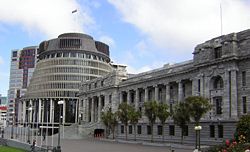
Since 17 October 2005, Labour has been in formal coalition with Jim Anderton, the Progressive Party's only MP. In addition to the parties in formal coalition, New Zealand First and United Future provide confidence and supply in return for their leaders being ministers outside cabinet. A further arrangement has been made with the Green Party, which has given a commitment not to vote against the government on confidence and supply. Since early 2007, Labour has also had the proxy vote of Taito Phillip Field, a former Labour MP. These arrangements assure the government of a majority of seven MPs on confidence votes.
The Leader of the Opposition is National Party leader John Key. The ACT party and the Māori Party are also in opposition. The Greens, New Zealand First and United Future each vote against the government on some legislation.
The highest court in New Zealand is the Supreme Court of New Zealand, which was established in 2004 following the passage of the Supreme Court Act 2003. The act also abolished the option to appeal to the Privy Council in London. The current Chief Justice is Dame Sian Elias. New Zealand's judiciary also includes the Court of Appeal; the High Court, which deals with serious criminal offences and civil matters at the trial level and with appeals from lower courts and tribunals; and subordinate courts.
New Zealand is the only country in the world in which all the highest offices in the land have been occupied simultaneously by women: Queen Elizabeth II, Governor-General Dame Silvia Cartwright, Prime Minister Helen Clark, Speaker of the House of Representatives Margaret Wilson and Chief Justice Dame Sian Elias were all in office between March 2005 and August 2006 (also of note New Zealand's largest listed company: Telecom New Zealand had a woman - Theresa Gattung as its CEO at the time).
Foreign relations and the military
New Zealand maintains a strong profile on environmental protection, human rights and free trade, particularly in agriculture.
New Zealand is a member of the following geopolitical organisations: APEC, East Asia Summit, Commonwealth of Nations, OECD and the United Nations. New Zealand has signed up to a number of free trade agreements, of which the most important are the China-New Zealand Free Trade Agreement & Closer Economic Relations with Australia.
For its first hundred years, New Zealand followed the United Kingdom's lead on foreign policy. In declaring war on Germany on 3 September 1939, Prime Minister Michael Savage proclaimed, "Where she goes, we go; where she stands, we stand". After the war, however, the United States exerted an increased influence on culture and the New Zealand people gained a clearer sense of national identity. New Zealand joined with Australia and the United States in the ANZUS security treaty in 1951, and later fought alongside the United States in both the Korean and the Vietnam Wars. In contrast, the United Kingdom became increasingly focused on its European interests following the Suez Crisis, and New Zealand was forced to develop new markets after the UK joined the EEC in 1973.
New Zealand has traditionally worked closely with Australia, whose foreign policy followed a similar historical trend. In turn, many Pacific Islands such as Western Samoa have looked to New Zealand's lead. The American influence on New Zealand was weakened by the disappointment with the Vietnam War, the sinking of the Rainbow Warrior by France, and by disagreements over environmental and agricultural trade issues and New Zealand's nuclear-free policy.
While the ANZUS treaty was once fully mutual between Australia, New Zealand and the United States, this is no longer the case. In February 1985, New Zealand refused nuclear-powered or nuclear-armed ships access to its ports. New Zealand became a Nuclear-free zone in June 1987, the first Western-allied state to do so. In 1986 the United States announced that it was suspending its treaty security obligations to New Zealand pending the restoration of port access. The New Zealand Nuclear Free Zone, Disarmament, and Arms Control Act 1987 prohibits the stationing of nuclear weapons on the territory of New Zealand and the entry into New Zealand waters of nuclear armed or propelled ships. This legislation remains a source of contention and the basis for the United States' continued suspension of treaty obligations to New Zealand.
Within New Zealand, there have been various wars between iwi, and between the British settlers and iwi. New Zealand has fought in the Second Boer War, World War I, World War II, the Korean War, the Malayan Emergency (and committed troops, fighters and bombers to the subsequent confrontation with Indonesia), the Vietnam War, the Gulf War and the Afghanistan War. It has also sent a unit of army engineers to help rebuild Iraqi infrastructure for one year during the Iraq War. As of 2008, New Zealand forces are still active in Afghanistan.
The New Zealand Defence Force has three branches: the New Zealand Army, the Royal New Zealand Navy, and the Royal New Zealand Air Force. New Zealand considers its own national defence needs to be modest; it dismantled its air combat capability in 2001. New Zealand has contributed forces to recent regional and global peacekeeping missions, including those in Cyprus, Somalia, Bosnia and Herzegovina, the Sinai, Angola, Cambodia, the Iran/Iraq border, Bougainville, East Timor, and the Solomon Islands.
Local government and external territories
The early European settlers divided New Zealand into provinces. These were abolished in 1876 so that government could be centralised, for financial reasons. As a result, New Zealand has no separately represented subnational entities such as provinces, states or territories, apart from its local government. The spirit of the provinces, however, still lives on, and there is fierce rivalry exhibited in sporting and cultural events. Since 1876, local government has administered the various regions of New Zealand. In 1989, the government completely reorganised local government, implementing the current two-tier structure of regional councils and territorial authorities which are constituted under the revised Local Government Act 2002 (New Zealand). In 1991, the Resource Management Act 1991 replaced the Town and Country Planning Act as the main planning legislation for local government.
Today, New Zealand has twelve regional councils for the administration of regional environmental and transport matters and seventy-three territorial authorities that administer roading, sewerage, building consents, and other local matters. The territorial authorities are sixteen city councils, fifty-seven district councils, and the Chatham Islands County Council. Four of the territorial councils (one city and three districts) and the Chatham Islands County Council also perform the functions of a regional council and thus are known as unitary authorities. Territorial authority districts are not subdivisions of regional council districts, and a few of them straddle regional council boundaries.
The regions are (asterisks denote unitary authorities): Northland, Auckland, Waikato, Bay of Plenty, Gisborne*, Hawke's Bay, Taranaki, Manawatu-Wanganui, Wellington, Marlborough*, Nelson*, Tasman*, West Coast, Canterbury, Otago, Southland, Chatham Islands*.
As a major South Pacific nation, New Zealand has a close working relationship with many Pacific Island nations, and continues a political association with the Cook Islands, Niue and Tokelau. New Zealand operates Scott Base in its Antarctic territory, the Ross Dependency. Other countries also use Christchurch to support their Antarctic bases and the city is sometimes known as the "Gateway to Antarctica".
|
|
|||||||||||
|---|---|---|---|---|---|---|---|---|---|---|---|
| Supranational level | Realm of New Zealand | ||||||||||
| National level | New Zealand | Tokelau | Cook Islands | Niue | Ross Dependency | ||||||
| Regions | 12 non-unitary regions | 4 unitary regions | Chatham Islands | Kermadec Islands | sub-Antarctic islands | ||||||
| Territorial authorities | 16 cities and 57 districts | ||||||||||
| Notes | Some districts lie in more than one region | These combine the regional and the territorial authority levels in one | Special territorial authority | Areas outside regional authority; these, plus the Chatham Islands and the Solander Islands, form the New Zealand Outlying Islands | State administered by New Zealand | States in free association with New Zealand | Claimed by New Zealand, but claim frozen by the Antarctic Treaty | ||||
Geography and environment
New Zealand comprises two main islands (called the North and South Islands in English, Te Ika a Maui and Te Wai Pounamu in Māori) and a number of smaller islands located near the centre of the water hemisphere. The North and South Islands are separated by the Cook Strait, which is 20km wide at its narrowest point. The total land area, 268,680 square kilometres (103,738 sq mi), is a little less than that of Italy and Japan, and a little more than the United Kingdom. The country extends more than 1,600 kilometres (1,000 miles) along its main, north-north-east axis, with approximately 15,134 km (9,404 mi) of coastline. The most significant of the smaller inhabited islands include Stewart Island/Rakiura; Waiheke Island, in Auckland's Hauraki Gulf; Great Barrier Island, east of the Hauraki Gulf; and the Chatham Islands, named Rēkohu by Moriori. The country has extensive marine resources, with the seventh-largest Exclusive Economic Zone in the world, covering over four million square kilometres (1.5 million sq mi), more than 15 times its land area.
The South Island is the largest land mass of New Zealand, and is divided along its length by the Southern Alps, the highest peak of which is Aoraki/Mount Cook at 3754 metres (12,320 ft). There are 18 peaks over 3,000 metres (10,000 ft) in the South Island. The North Island is less mountainous than the South, but is marked by volcanism. The highest North Island mountain, Mount Ruapehu (2,797 m / 9,177 ft), is an active cone volcano. The dramatic and varied landscape of New Zealand has made it a popular location for the production of television programmes and films, including the Lord of the Rings trilogy and the The Last Samurai.
The country owes its varied topography, and perhaps even its emergence above the waves, to the dynamic boundary it straddles between the Pacific and Indo-Australian Plates. New Zealand is part of Zealandia, a continent nearly half the size of Australia that is otherwise almost completely submerged. About 25 million years ago, a shift in plate tectonic movements began to pull Zealandia apart forcefully, with this now being most evident along the Alpine Fault and in the highly active Taupo volcanic zone.
New Zealand is culturally and linguistically part of Polynesia, and constitutes the south-western anchor of the Polynesian Triangle.
The latitude of New Zealand (ranging from approximately 34 to 47°S) corresponds closely to that of Italy in the Northern Hemisphere. However, its isolation from continental influences and exposure to cold southerly winds and ocean currents gives the climate a much milder character. The climate throughout the country is mild and temperate, mainly maritime, with temperatures rarely falling below 0 ° C (32 ° F) or rising above 30 °C (86 °F) in populated areas. Temperature maxima and minima throughout the historical record are 42.4 °C (108.3 °F) in Rangiora, Canterbury and -21.6 °C (-6.9 °F) in Ophir, Otago. Conditions vary sharply across regions from extremely wet on the West Coast of the South Island to semi-arid (Köppen BSh) in the Mackenzie Basin of inland Canterbury and subtropical in Northland. Of the main cities, Christchurch is the driest, receiving only 640 mm (25 in) of rain per year; Auckland, the wettest, receives almost twice that amount. Auckland, Wellington and Christchurch all receive a yearly average in excess of 2000 hours of sunshine per annum. The southern and south-western parts of South Island have a cooler and cloudier climate, with around 1400–1600 sunshine hours per annum; whilst the northern and north-eastern parts of the South Island are the sunniest areas of the country and receive approximately 2400–2500 sunshine hours per annum.
Biodiversity
Because of its long isolation from the rest of the world and its island biogeography, New Zealand has extraordinary flora and fauna, descended from Gondwanan wildlife or since arriving by flying, swimming or being carried across the sea . About 80% of New Zealand's flora is endemic, including 65 endemic genera. The two main types of forest are those dominated by podocarps and/or the giant kauri, and in cooler climates the southern beech. The remaining vegetation types in New Zealand are grasslands of tussock and other grasses, usually in sub-alpine areas, and the low shrublands between grasslands and forests.
Until the arrival of humans, 80% of the land was forested. Until 2006, it was thought, barring three species of bat (one now extinct), there were no non-marine native mammals. However, in 2006, scientists discovered bones that belonged to a long-extinct, unique, mouse-sized land animal in the Otago region of the South Island.. New Zealand's forests were inhabited by a diverse range of megafauna, including the flightless moas (now extinct), four species of kiwi, the kakapo and the takahē, all endangered by human actions. Unique birds capable of flight included the Haast's eagle, which was the world's largest bird of prey (now extinct), and the large kākā and kea parrots. Reptiles present in New Zealand include skinks, geckos and living fossil tuatara. There are four endemic species of primitive frogs. There are no snakes and there is only one venomous spider, the katipo, which is rare and restricted to coastal regions. However, there are many endemic species of insects, including the weta, one species of which may grow as large as a house mouse and is the heaviest insect in the world.
New Zealand has suffered a high rate of extinctions, including the moa species, the huia, laughing owl and flightless wrens (which formerly occupied the roles elsewhere occupied by mice). This is due to human activities such as hunting and pressure from introduced feral animals, such as weasels, stoats, cats, goats, deer and brushtailed possums. Five indigenous vascular plant species are now believed to be extinct, including Adam's mistletoe and a species of forget-me-not.
However, New Zealand has led the world in island restoration projects where offshore islands are cleared of introduced mammalian pests and native species are reintroduced. Several islands located near to the three main islands are wildlife reserves where common pests such as possums and rodents have been eradicated to allow the reintroduction of endangered species to the islands. A more recent development is the mainland ecological island.
Economy
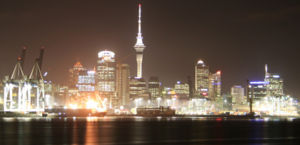
New Zealand has a modern, prosperous, developed economy with an estimated nominal Gross domestic product (GDP) of US$128.1 billion (as of 2008). The country has a relatively high standard of living with an estimated GDP per capita of US$30,234 in 2008 which is comparable to Southern Europe; e.g. Spain US$33,385, but lower than the United States at US$46,820. Since 2000 New Zealand has made substantial gains in median household income. New Zealand, along with Australia, largely escaped the early 2000s recession that impacted upon most other advanced countries.
New Zealanders have a high level of life satisfaction as measured by international surveys; this is despite lower GDP per-head levels than many other OECD countries. The country was ranked 20th on the 2006 Human Development Index and 15th in The Economist's 2005 world-wide quality-of-life index. The country was further ranked 1st in life satisfaction and 5th in overall prosperity in the 2007 Legatum Institute prosperity index. In addition, the 2007 Mercer Quality of Living Survey ranked Auckland 5th place and Wellington 12th place in the world on its list.
The tertiary sector is the largest sector in the economy (68.8% of GDP), followed by the secondary sector (26.9% of GDP) and the primary sector (4.3% of GDP).
New Zealand is a country heavily dependent on trade, particularly in agricultural products. Exports account for around 24% of its output, which is a relatively high figure (it is around 50% for many smaller European countries). This makes New Zealand particularly vulnerable to international commodity prices and global economic slowdowns. Its principal export industries are agriculture, horticulture, fishing and forestry. These make up about half of the country's exports. Its major export partners are Australia 20.5%, US 13.1%, Japan 10.3%, China 5.4%, UK 4.9% (2006).
Tourism plays a significant role in New Zealand's economy. Tourism contributes $12.8 billion (or 8.9%) to New Zealand’s total GDP and supports nearly 200,000 full-time equivalent jobs (9.9% of the total workforce in New Zealand). Tourists to New Zealand are expected to increase at a rate of 4% annually up to 2013.
Recent trends
Historically New Zealand enjoyed a high standard of living which relied on its strong relationship with the United Kingdom, and the resulting stable market for its commodity exports. New Zealand's economy was also built upon on a narrow range of primary products, such as wool, meat and dairy products. High demand for these products - such as the New Zealand wool boom of 1951 created sustained periods of economic prosperity. However, in 1973 the United Kingdom joined the European Community which effectively ended this particularly close economic relationship between the two countries. During the 1970s other factors such as the oil crises undermined the viability of the New Zealand economy; which for periods before 1973 had achieved levels of living standards exceeding both Australia and Western Europe. But these events led to a protracted and very severe economic crisis, during which living standards in New Zealand fell behind those of Australia and Western Europe, and by 1982 New Zealand was the lowest in per-capita income of all the developed nations surveyed by the World Bank.
Since 1984, successive governments have engaged in major macroeconomic restructuring, transforming New Zealand from a highly protectionist and regulated economy to a liberalised free-trade economy. These changes are commonly known as Rogernomics and Ruthanasia after Finance Ministers Roger Douglas and Ruth Richardson. A recession began after the 1987 share market crash and caused unemployment to reach 10% in the early 1990s. However the economy recovered and New Zealand’s unemployment rate is now the second lowest of the twenty-seven OECD nations with comparable data (3.7%).
The current government's economic objectives are centred on pursuing free-trade agreements and building a " knowledge economy". On April 7th 2008, New Zealand and China signed the New Zealand China Free Trade Agreement, the first such agreement China has signed with a developed country. Ongoing economic challenges for New Zealand include a current account deficit of 7.9% of GDP, slow development of non-commodity exports and tepid growth of labour productivity. New Zealand has experienced a series of " brain drains" since the 1970s, as well educated youth leaving permanently for Australia, Britain or the United States. "Kiwi lifestyle" and family/ whanau factors motivates some of the expatriates to return, while career, culture, and economic factors tend to be predominantly 'push' components, keeping these people overseas. In recent years, however, a brain gain brought in educated professionals from poor countries, as well as Europe, as permanent settlers.
Agriculture
Agriculture has been and continues to be the main export industry in New Zealand. In the year to June 2007, dairy products accounted for 21% ($7.5 billion) of total merchandise exports, and the largest company of the country, Fonterra, a dairy cooperative, controls almost one-third of the international dairy trade. Other agricultural items were meat 13.2%, wood 6.3%, fruit 3.5% and fishing 3.3%. New Zealand also has a thriving wine industry.
Livestock are rarely housed, but feeding of small quantities of supplements such as hay and silage can occur, particularly in winter. Grass growth is seasonal, largely dependent on location and climatic fluctuations but normally occurs for between 8-12 months of the year. Stock are grazed in paddocks, often with moveable electric fencing around the farm. Lambing and calving are carefully managed to take full advantage of spring grass growth.
Demography
New Zealand has a population of about 4.2 million, of which approximately 78% identify with European ethnic groups. New Zealanders of European descent are collectively known as Pākehā; this term generally refers to New Zealanders of European descent but some Māori use it to refer to all non-Māori New Zealanders. Most European New Zealanders are of British and Irish ancestry, although there has been significant Dutch, Dalmatian, Italian, and German immigration together with indirect European immigration through Australia, North America, South America and South Africa. According to the 2001 census projections, by 2021 European children will make up 63% of all New Zealand children, compared with 74% in 2001. The birthrate is very high for a developed country. The birthrate as of February 2008 was 2.2 per woman, compared to approximately 2 for the previous 30 years, with the total number of births higher than at any point since 1961. The life expectancy of a child born in 2008 was 81.9 years for a girl, and 77.9 years for a boy.
Indigenous Māori people are the largest non-European ethnic group, accounting for 14.6% of the population in the 2006 census. While people could select more than one ethnic group, slightly more than half (53%) of all Māori residents identified solely as Māori. People identifying with Asian ethnic groups account for 9.2% of the population, increasing from 6.6% in the 2001 census, while 6.9% of people are of Pacific Island origin.
While the demonym is New Zealander, New Zealanders informally call themselves Kiwi or Kiwis.
New Zealand is also a predominantly urban country, with 72.2% of the population living in 16 main urban areas and more than half living in the four largest cities of Auckland, Hamilton, Wellington and Christchurch.
New Zealand immigration policy is relatively open; its government is committed to increasing its population by about 1% annually. In 2004–05, a target of 45,000 was set by the New Zealand immigration Service. Twenty three percent of the population was born overseas, one of the highest rates anywhere in the world. At present, immigrants from the United Kingdom and Ireland constitute the largest single group, accounting for 29% of those born overseas but immigrants are drawn from many nations, and increasingly from East Asia (mostly China, but with substantial numbers also from Korea, Taiwan, Japan, and Hong Kong).
| New Zealand religious beliefs | ||||
|---|---|---|---|---|
| Christianity | 56% | |||
| No religion | 35% | |||
| Others | 5% | |||
According to the 2006 census, Christianity is the predominant religion in New Zealand, held by 55.6% of the population, a decrease from 60.6% at the 2001 census. Another 34.7% indicated that they had no religion, up from 29.6% in 2001, and 5% affiliated with other religions. The main Christian denominations are Anglicanism, Roman Catholicism, Presbyterianism and Methodism. There are also significant numbers who identify themselves with Pentecostal and Baptist churches and with the LDS (Mormon) church. The New Zealand-based Ratana church has adherents among Māori. According to census figures, other significant minority religions include Hinduism, Buddhism, and Islam.
Until 1987, English was New Zealand's only official language, and remains predominant in most settings; Māori became an official language under the 1987 Māori Language Act and New Zealand Sign Language under the 2006 New Zealand Sign Language Act. The two official languages are the most widely spoken; English by 98% of the population and Māori by 4.1%. Samoan is the most widely spoken non-official language (2.3%), and French, Hindi, Yue and Northern Chinese are also widely spoken.
New Zealand has an adult literacy rate of 99%, and 14.2% of the adult population has a bachelor's degree or higher. For 30.4% of the population, some form of secondary qualification is their highest, while 22.4% of New Zealanders have no formal qualification.
Culture
Overview
Much of contemporary New Zealand culture is derived from British roots. It also includes significant influences from American, Australian and Māori cultures, along with those of other European cultures and – more recently – non-Māori Polynesian and Asian cultures. Large festivals in celebration of Diwali and Chinese New Year are held in several of the larger centres. The world's largest Polynesian festival, Pasifika, is an annual event in Auckland. Cultural links between New Zealand and the United Kingdom and Ireland are maintained by a common language, sustained migration from the United Kingdom and Ireland, and many young New Zealanders spending time in the United Kingdom/Ireland on their " overseas experience" (OE). The music and cuisine of New Zealand are similar to that of Britain and the United States, although both have some distinct New Zealand and Pacific qualities.
Māori culture has undergone considerable change since the arrival of Europeans; in particular the introduction of Christianity in the early 19th century brought about fundamental change in everyday life. Nonetheless the perception that most Māori now live similar lifestyles to their Pākehā neighbours is a superficial one. In fact, Māori culture has significant differences, for instance the important role which the marae and the extended family continues to play in communal and family life. As in traditional times, karakia are habitually performed by Māori today to ensure the favorable outcome of important undertakings, but today the prayers used are generally Christian. Māori still regard their allegiance to tribal groups as a vital part of personal identity, and Māori kinship roles resemble those of other Polynesian peoples. As part of the resurgence of Māori culture that came to the fore in the late 20th century, the tradition-based arts of kapa haka (song and dance), carving and weaving are now more widely practiced, and the architecture of the marae maintains strong links to traditional forms. Māori also value their connections to Polynesia, as attested by the increasing popularity of waka ama (outrigger canoe racing), which is now an international sport involving teams from all over the Pacific.
Te Reo Māori
Use of the Māori language ( Te Reo Māori) as a living, community language remained only in a few remote areas in the post-war years, but is currently undergoing a renaissance, thanks in part to Māori language immersion schools and two Māori Television channels. This is the only nationwide television channel to have the majority of its prime-time content delivered in Māori, primarily because only 4% of the population speak Te Reo Maori. However, partly in recognition of the importance of Māori culture to New Zealand, the language was declared one of New Zealand's official languages in 1987.
Movies
Although films have been made in New Zealand since the 1920s, it was only from the 1970s that New Zealand films began to be produced in significant numbers. Films such as Sleeping Dogs and Goodbye Pork Pie achieved local success and launched the careers of actors and directors including Sam Neill, Geoff Murphy and Roger Donaldson. In the early 1990s, New Zealand films such as Jane Campion's Academy Award-winning film The Piano, Lee Tamahori's Once Were Warriors and Peter Jackson's Heavenly Creatures began to garner international acclaim. In the late 1990s and early 2000s, Jackson filmed The Lord of the Rings film trilogy in New Zealand, using a mostly New Zealand crew and many New Zealand actors in minor parts. Whale Rider, originally a novel by Witi Ihimaera, was produced in 2002 and received recognition from various festivals and awards. Many non-New Zealand productions, primarily from Hollywood but also from Bollywood, have been made in New Zealand.
Sports

Sport has a major role in New Zealand's culture, with the unofficial national sport of rugby union being particularly influential. Other popular participatory sports include cricket, bowls, netball, soccer, golf , swimming and tennis. New Zealand has strong international teams in several sports including rugby union, netball, cricket, rugby league, and softball. New Zealand also does traditionally well in the sports of rowing, yachting and cycling. The country is internationally recognised for performing well on a medals-to-population ratio at Olympic Games and Commonwealth Games.
Rugby union, which is commonly referred to as simply rugby in New Zealand, is closely linked to the country's national identity. The national rugby team, the All Blacks, have the best win to loss record of any national team, and are well known for the haka (a traditional Māori challenge) that they perform before the start of international matches. New Zealand is also well known for its extreme sports and adventure tourism. Its reputation in extreme sports extends from the establishment of the world's first commercial bungee jumping site at Queenstown in the South Island of New Zealand in November 1988; its roots in adventure tourism can be traced all the way back to Sir Edmund Hillary, the first person to reach the summit of Mount Everest.


